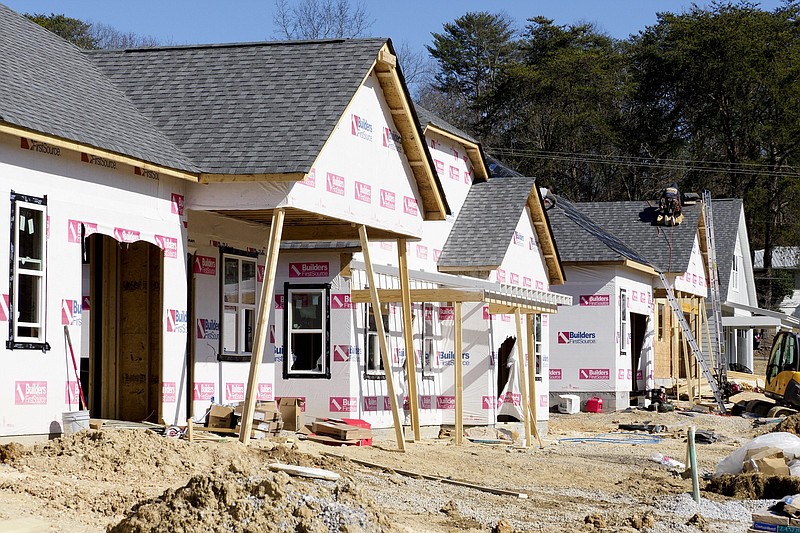If one shocker of our COVID-19 pandemic era has been the enthusiastic embrace of fixing up our homes, a second and related shocker has been the skyrocketing cost of lumber.
With lots of working and schooling at home over the past year, our space got tight. And we gave our homes a new look, seeing both their limitations and their possibilities.
Many contractors and handyman companies say the past year has been the busiest of their careers as we set about renovating houses to accommodate home offices, classroom dens, or porches and sun rooms to offer new play areas.
But then the sticker shock hit.
Lumber prices overall are up a staggering 188%, according to Fortune magazine under a headline that questions "When will the wood shortage end?"
Well, there's a lot to unpack here, but part of the problem (but only part of it, more on this later) is the pandemic itself, and a basic tenet of supply and demand.
When states issued lockdowns in the spring of 2020, sawmills across the nation closed, prompting a drop in the lumber supply - not unlike the empty bathroom tissue and cleaning supply shelves we saw about that same time. Meanwhile, a number of Americans, suddenly caged at home, thought it seemed like a great time to start renovations or do-it-yourself projects, prompting a rise in demand for timber. The supply-and-demand dynamic was made worse by low interest rates and tight existing home inventory, both of which caused new home builders to ramp up production. The demand for new homes is so high that even during an economic crisis we hit a 14-year high in new housing starts in December.
As for when will it end? That's trickier. Maybe in part when we all figure out that it's smart to get vaccinated?
We're not kidding. That's one answer offered to Fortune by Dustin Jalbert, a wood prices specialist and senior economist at Fastmarkets RISI.
"If" COVID-19 cases decrease (the U.S. is currently in the fourth week of an upward trend in cases, according to the Centers for Disease Control and Prevention), vaccinations roll out successfully "and we achieve some level of herd immunity, I expect mill production to ramp up and distribution delays to start dissipating. Supply should increase in the coming months," Jalbert said.
If nothing else could convince us to plead with our loved ones and neighbors to get vaccinated, perhaps the spectre of an added of $24,000 to every new single-family home price might?
But there's more to blame than just the pandemic. Or materials shortages following the Texas ice storm. Or the blocked arteries of either the Suez or the Panama canals, or any other myriad theories of rising wood costs.
You may recall the headlines of April 2017 when then-president Donald Trump - the genius businessman who managed to bankrupt himself or his various companies at least six times - put in place 20% tariffs on Canadian lumber. That was Canadian lumber which, before that, provided between a quarter and a third of all lumber used in American building.
Bloomberg's Industry Week wrote at the time that the tariff was set in motion by a petition from U.S. timber companies for duties on lumber imports from Canada, saying that Canada unfairly subsidizes its timber industry. Susan Yurkovich, president of the B.C. Lumber Trade Council, the action "was driven by the same protectionist lumber lobby in the U.S. whose sole purpose is to create artificial supply constraints on lumber and drive up prices for their benefit, at the expense of American consumers."
It's important to note that the two neighbor countries have been squabbling over lumber trade policy since the 1800s.
Over the years, the U.S has brought legal challenges against Canada to both NAFTA and the World Trade Organization. Canada won the argument each time, with the courts saying the Canadian government does not, in fact, improperly subsidize the industry.
Kevin Mason, a Canadian timber industry financial analyst for the firm ERA Forest Products Research, in 2018 told the Market Urbanism Report: "Just because the government controls the trees and sets the price [in Canada] doesn't mean it's not market-based."
The likelier cause for any possible price discrepancy, according to the article, is that Canada has various comparative advantages on lumber, such as more forest area and a renewed government emphasis on reducing deforestation.
"American denial about Canada's advantages may be about politics more than anything else," the Report wrote. "The U.S. logging industry, according to the Bureau of Labor Statistics, is one in which workers without college educations earn a respectable median annual salary of $37,000. It's also an industry where domestic employment figures are declining. If part of Trump's economic platform is to shut off global competitors and restore jobs, the timber industry would be a good start," the Report wrote.
The problem is that it inflicted costs on many more Americans who don't work in the timber industry.
By August of 2020, the National Association of Home Builders was crying foul and urging renewed trade talks with Canada, according to the Engineering News Record, a construction industry publication. In December, then-President Trump dropped the tariffs on Canadian lumber to 9%.
But it was too little, too late - much like the former guy's effort to fight the pandemic.
